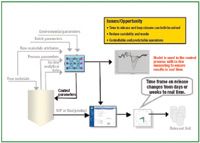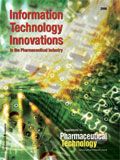Leveraging PAT: What Life-Sciences Companies Can Learn from Other Industries
This article examines what other industries have done to address the challenges associated with successfully implementing the principles and concepts of process analytical technology, particularly the specific elements of measurement, analysis, and control. The author explores how other industries' approaches can be applied directly to pharmaceutical manufacturing.
A global plastic manufacturer operates one of its plants at 104% of its theoretical maximum production rate. A cement company achieves 32% reduced product variability and improved process stabilization. Why are these industries' productivity values relevant to the pharmaceutical industry, and how are they attaining those results?

These companies demonstrate the benefits of measuring, analyzing, and controlling processes to achieve business benefits using principles that life-sciences companies are pursuing today under the process analytical technology (PAT) umbrella. Of course, the life-sciences industry has understood the returns that stem from quality assessment and adaptive development. So, why are experienced industry executives asking, "Haven't we been doing this for 20 years in our industry?"
Make no mistake: the challenges in the pharmaceutical industry are definitely unique because of the industry's highly sophisticated regulations and complex processes such as cell culture and antibiotic fermentations. Still, there have been lessons already learned and problems that have already been solved in consumer products, refining, metals, and a host of other industries. With the US Food and Drug Administration's PAT initiative, the pharmaceutical industry is now heavily engaged in evaluating its own measurement, analysis, and control capabilities and it is looking to other industries for proven technologies and approaches that may be able to transfer to pharmaceutical operations.
Importance of PAT in process control
PAT goes far beyond closed-loop control, which has been a standard operating procedure in other industries for a long time, and it isn't completely new to life sciences, especially in biotechnology and fermentation processes. Unfortunately, much of the past emphasis on applying good chemical engineering principles to drug manufacturing was put aside during the past several years as the industry redirected its attention to Y2K, business-system implementations, and 21 CFR Part 11. The result may have enhanced compliance, but it did little to achieve the goal of pharmaceutical manufacturing, which is to make high-quality products.
FDA's PAT initiative allows pharmaceutical manufacturers to refocus on improving their processes for making drug products more efficiently and with less variability. Moreover, it allows companies to focus on determining which variables are most critical to the final desired product and where controls should be inserted and implemented into the development cycle. The success of PAT is applying the process-monitoring tools needed to analyze each of the critical product attributes and then effectively and accurately controlling them. Detecting errors or process deviations and correcting them while the product is being made is more cost-efficient and can help justify flexible regulatory paths for innovations in manufacturing as well as postapproval changes.
Applying principles associated with the PAT initiative that have been identified by FDA, including process understanding and real-time releases, requires a change in technology and techniques currently used in many pharmaceutical operations. Life-sciences companies have undertaken numerous pilot projects to determine:
- how to measure what must be measured (sensor development);
- how to validate those measurements to identify meaningful process-parameter relationships;
- how to integrate advanced strategies to achieve reliable, predictable operations.
Defining and implementing an architecture that incorporates all of these elements is critical to achieving real-time releases of product that leverages PAT principles and brings to fruition the business benefits that are the driving forces behind these investments.
FDA identifies the tools for supporting innovation as multivariate tools for design, data acquisition, and analysis; process analyzers; process-control tools; and continuous-improvement and knowledge-management tools (see Figure 1).

Figure 1: Tools and parameters to support and implement process analytical technology principles during pharmaceutical product development.
This article examines the specific elements of measurement, analysis, and control and what other industries have done to address these challenges in successful implementations using concepts that can be applied directly to the life-sciences industry.
Measuring process parameters
What type of sensors must be in place to measure which process parameters? Many companies are undergoing sensor development pilots, realizing that if a parameter can't be measured, it can't be analyzed or controlled. Some sensing problems can be solved with existing analytical instrumentation, but others will require new technology to measure the parameter of interest in a nondestructive, real-time manner.
Food, beverage, drinking-water, and wastewater industries are finding that multielement sensors (MEMS) applications can help them identify trace contaminants, degradation patterns in fluids, and subtle patterns in chemical fingerprints correlated to quality. MEMS can simultaneously provide five or more process readings on one sensor, including, for example, pH, oxidation, viscosity, and temperature. MEMS units also can withstand sterilization and harsh conditions. There is clearly a trend toward digital sensors, smart sensors (e.g., local processing and lab-on-a-chip devices) and distributed sensor networks. Within the sensor arena, considerable effort is expended on biosensors and MEMs devices such as microfluidics, and new sensors for biological applications appear almost weekly.
Analyzing critical process parameters
What data are necessary for analyzing critical process parameters, and what are the tools that will be needed to conduct these analyses? FDA has identified the tools and concepts supporting innovation as "multivariate tools for design, data acquisition, and analysis; process analyzers; process-control tools; and continuous-improvement and knowledge-management tools." There are several off-the-shelf tools on the market that have been proven in pharmaceutical and other industries and that use a range of multivariate techniques to analyze process data. But tools such as these will not magically provide the answers about which parameters are critical control parameters or how to control a process.
Good process knowledge must be applied to determine which data sets to include, how to reconcile disparate data—such as time-stamped, tag-based data; sample-based analytical data; and raw-material parameters—and how the data should be cleansed and preprocessed. For example, in a batch or fed-batch operation, what is the best way to unfold the data to capture the maximum information content while producing valuable results? The bottom line on data analysis is that there are many algorithms and tools available, and applying good process knowledge during the analysis will help achieve the best results.
Process control
What about closed-loop control and real-time releases? As in other industries, implementing the elements of PAT is only valuable if it ultimately helps a pharmaceutical company achieve its business goal. Process-control tools, the third of the PAT tools identified by FDA, help realize the potential of accurate sensor measurements and analysis.
For example, a cement manufacturer achieved more consistent product quality using on-line, closed-loop multivariate control in its milling operations. Using a multivariable predictive controller and soft sensors, the mill optimizer ensured smooth handling of process nonlinearities across multiple process units. In abnormal conditions, the optimizer switched to a rule-based control mechanism to restore stability. The result was a 30% reduction in product variability and improved process stabilization.
An alphaolefins plant operated at 105% of its theoretical maximum production rate as a result of optimized closed-loop control. The oxidation rate in the batch processing is now carefully controlled with multiple setpoints to achieve consistent quality with virtually no rework or waste—far improved over the 30% rework before closed-loop control. Batch processes such as these have parallels in pharmaceutical batch processes.
The path to progress
For a process that involves one product on a dedicated process line, solving the measure, analysis, and control problem could be done with one set of sensors, one analysis tool, and one data source. The reality is that most facilities are not dedicated sites, and each process line may produce many products. In this environment, one of the fundamental challenges with implementing advanced measurement, analysis, and optimization is that many different and disparate data sources can arise. On the path to realizing PAT's potential, industry leaders have proposed structured architectures for implementing PAT tools and concepts within manufacturing environments. Integrating PAT into the architecture of a plant provides a foundation for continuous improvement in operations, FDA's fourth PAT tool.
To become more competitive and profitable in the global economy, life-sciences companies have had to restructure their operations to cut costs and improve operational efficiencies. Many have embraced FDA initiatives such as PAT that promote advances in automation control and information technology to make process-improvement efficiencies possible and reduce business risk.
The potential benefits of PAT for the life-sciences industry more than offset the immediate challenges in measuring, analyzing, and controlling a company's processes. By leveraging the successes achieved in other industries where quality is paramount and margins drive efficiency, a company may find an unexpected source of new solutions that apply to life sciences in the new world of PAT.
Bonnie Haferkamp is the life-sciences industry marketing lead at Rockwell Automation, 1201 South Second St., Milwaukee, WI 53204-2496, tel. 414.382.4329
Keywords: automation, control, manufacturing, process analytical technology

Drug Solutions Podcast: A Closer Look at mRNA in Oncology and Vaccines
April 30th 2024In this episode fo the Drug Solutions Podcast, etherna’s vice-president of Technology and Innovation, Stefaan De Koker, discusses the merits and challenges of using mRNA as the foundation for therapeutics in oncology as well as for vaccines.
Pharmaceutical Tariffs Are Imminent: How Industry is Bracing for Impact
April 16th 2025On April 14, 2025, the Trump Administration launched a national security-driven investigation into pharmaceuticals, a move that will likely result in tariffs being placed on pharmaceutical drugs, ingredients, and other components that are imported from outside of the United States.